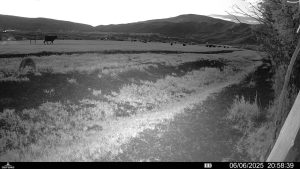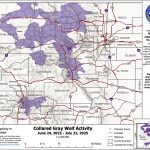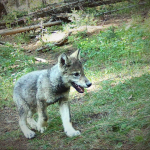Copper Creek wolf pack responsible for seventh livestock attack in Pitkin County, wildlife officials say
This is the pack’s first confirmed kill since Colorado Parks and Wildlife took action in late May, while ranchers in the area report continued conflict
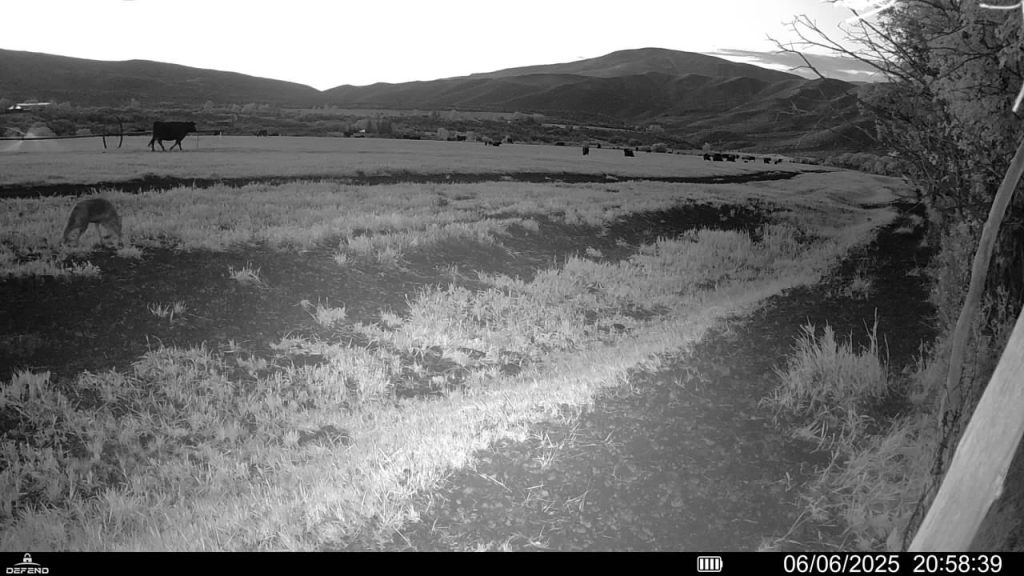
Chris Collins/Courtesy Photo
The Copper Creek wolf pack was tied to another calf death in Pitkin County in mid-July, marking the seventh depredation incident tied to the group this year. The area’s ranchers, however, believe the pack is responsible for losses now well into the double digits.
Colorado Parks and Wildlife staff confirmed the calf’s death as a wolf depredation on July 18, citing strong evidence that wolves were involved, according to a video of the investigation captured by Chris Collins, who owns McCabe Ranch in Old Snowmass. Collins shared footage with the Vail Daily.
The calf — which was owned by Brad Day, a lessee on the ranch — was found by a Parks and Wildlife range rider around 30 feet from the Hay Park Trail in the Capitol Creek area, Collins said. In the video, the Parks and Wildlife staff member identifies that one of the calf’s ligaments was bitten through, likely by a wolf, and appeared to have died from an infection related to that wound. Other injuries, he added, indicated that other animals had scavenged from the carcass.
Luke Perkins, a spokesperson with Parks and Wildlife, confirmed that the agency believes the Copper Creek Pack was involved.
Four of the Copper Creek Pack’s yearlings and its matriarch were released in Pitkin County in January after being held in a wildlife sanctuary for around four months. The pack had been captured and relocated to the sanctuary after being connected to repeated livestock attacks in Grand County, where it denned in 2024. While the pack’s original patriarch died shortly after capture — from injuries related to a gunshot wound it obtained in the wild — the adult female bred with one of the British Columbia wolves this spring and had additional pups.
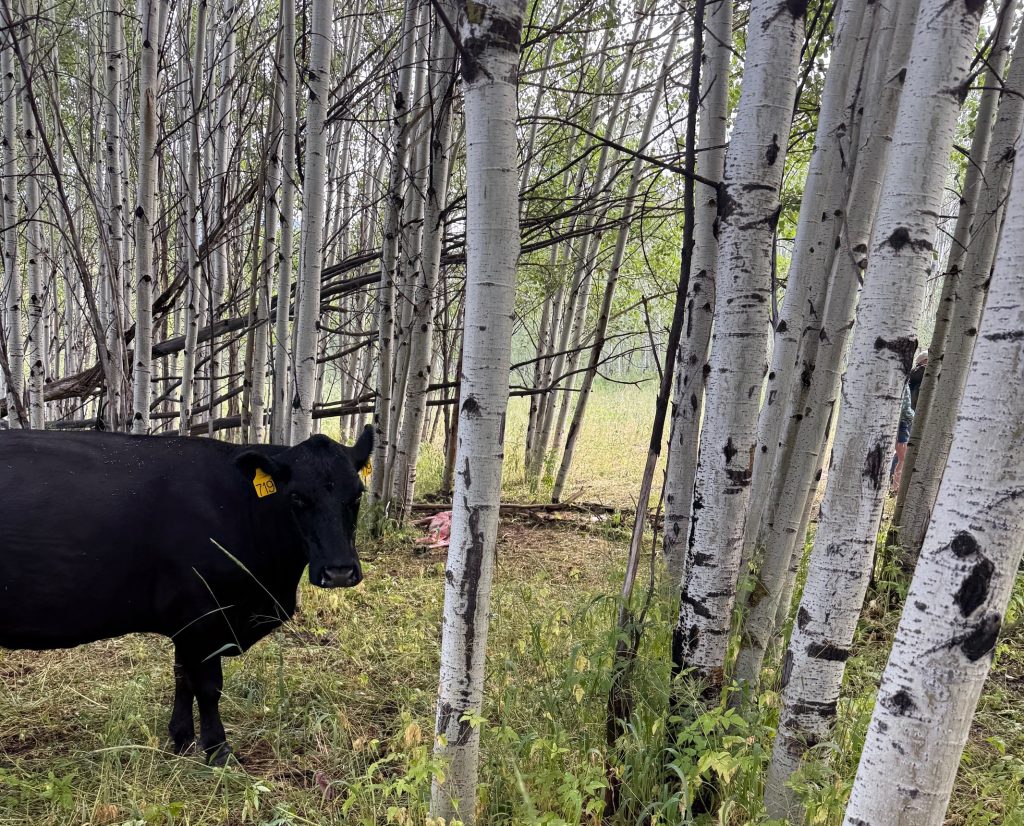
The July 18 depredation comes around two months after Parks and Wildlife killed one of the pack’s yearlings to curb the pack’s predation on livestock in the Capitol Creek Valley.
Just before Parks and Wildlife killed the yearling, wolves from the pack were connected to four livestock attacks in eight days, meeting the agency’s definition for “chronic depredation.” That determination, paired with the fact that the impacted producers had utilized appropriate nonlethal deterrence methods, necessitated the killing of the yearling, according to Parks and Wildlife.
Per the chronic depredation management directive issued by the agency, this is part of an “incremental approach” to attempt to alter the pack’s behavior and steer them away from seeing livestock as a food source. After killing one wolf responsible, the agency moves into an “evaluation period” to determine whether it works. From there, should the pack continue to kill and attack livestock, the agency can kill another wolf.
Perkins said that the agency “continues to closely monitor the Copper Creek Pack’s behavior and is considering its options consistent” with this directive.
Conflict between wolves and livestock persists
While the July 18 discovery of the calf marks the calf’s first confirmed depredation since the yearling’s death, ranchers in the area have reported continued conflict and additional suspected attacks.
“Nothing’s really changed,” Collins said. “They’re staying so close to the cows …I hear them almost every night at my house.”
Collins detailed multiple incidents he has seen, as well as reports from residents in the area of wolf sightings and shared videos of wolves harassing livestock. This included sightings of wolves walking through his livestock pasture 50 feet behind his home, a neighbor seeing two wolves chasing calves in the early morning at a nearby ranch, sightings along and across Capitol Creek Road and more.
Parks and Wildlife has had at least two of the state-contracted range riders stationed in the area for the last few months. However, over the Fourth of July weekend, the riders were temporarily removed Friday and Saturday, and producers immediately saw a change in wolf behavior.
“Nobody was here and (the wolves) chased our cows out of the forest,” Collins said. “It took us three days to gather those cattle.”
Collins said that between himself, Brad Day and Mike Cerveny, a lessee at Lost Marbles Ranch in Old Snowmass, there have been around 20 calves lost this year. (Parks and Wildlife has confirmed five wolf depredation incidents at both McCabe and Lost Marble ranches.)
“As soon as we hit that depredation level to where it’s chronic, then things stop being confirmed,” Collins said.
The producers in the area have reported several other incidents since May, where cows and calves were injured or killed; however, none have been confirmed as wolf depredations. At a special July 7 Parks and Wildlife Commission meeting to discuss the pack, Matt Yamashita, a district wildlife manager based in Glenwood Springs, said these investigations lacked the evidence required to confirm a wolf was responsible for the animal’s death.
In one of these instances, Collins said the depredation was reported at least one day after it occurred, when all that was left was a spine and a rib cage.
“It was completely gone,” Collins said, adding that he believes a wolf was responsible because there were tracks “all around that area” and he saw one walking through a pasture 300 yards from his cattle the day before the remains were found.
Part of the challenge in preventing, finding and confirming losses lies in the landscape where the livestock currently roam.
Like many Western Slope producers, the Capitol Creek ranches have permits to move their cattle onto U.S. Forest Service land during the summer. These allotments comprise thousands of acres of terrain that Garrett Watson, Parks and Wildlife’s northwest deputy regional manager based in Grand Junction, described as vast and steep with dense vegetation, which makes monitoring cattle — including to prevent wolf attacks and to find injured or killed animals — extremely difficult.
“We can’t ride (on the range) every day,” Collins said. “It’s not possible to be up there and/or to see much. It’s such a big space, and it’s not divided into pastures. So when you let those cows loose, they go off two or three together and they’re spread out all over the place, which is really what they’re supposed to be doing.”
Given the reality of the landscape, Parks and Wildlife staff, including its director, Jeff Davis, acknowledged that there had been continued conflict and that additional depredations were possible.
“Given the topography, the size of the landscape, and the dense vegetation, I think we’re trying to keep an open mind to that and understand that that is a possibility that we have more wolf-related depredations,” Davis said on July 7.
Regardless of losses, the producers could see financial impacts in the form of reduced weights and pregnancy rates, Collins said.
“When you lose one cow, you lose a minimum of two years of production, and that’s where it starts getting really, really difficult,” he said.
“We’ve already sold our calves for this year,” Collins said, adding that the sales are made based on a predicted weight the calves will be at the end of the season. “When you have these kinds of problems — that we don’t even know the extent of — because we haven’t had a season yet where we’re going to bring them down off the mountains and see what they weigh, we might not make our contract.”
The state provides compensation for direct and indirect losses, and has paid $412,546.43 in wolf-related claims since the program’s start in December 2023. This number does not include claims paid in July, including at least around $130,000 in settlements approved at the July 18 Parks and Wildlife commissioner meeting. In addition to the seven incidents in Pitkin County, Parks and Wildlife has confirmed seven other wolf-related livestock attacks in Rio Blanco, Eagle, Gunnison, Grand, Jackson and Routt counties this year.
Mitigating conflict with the wolves
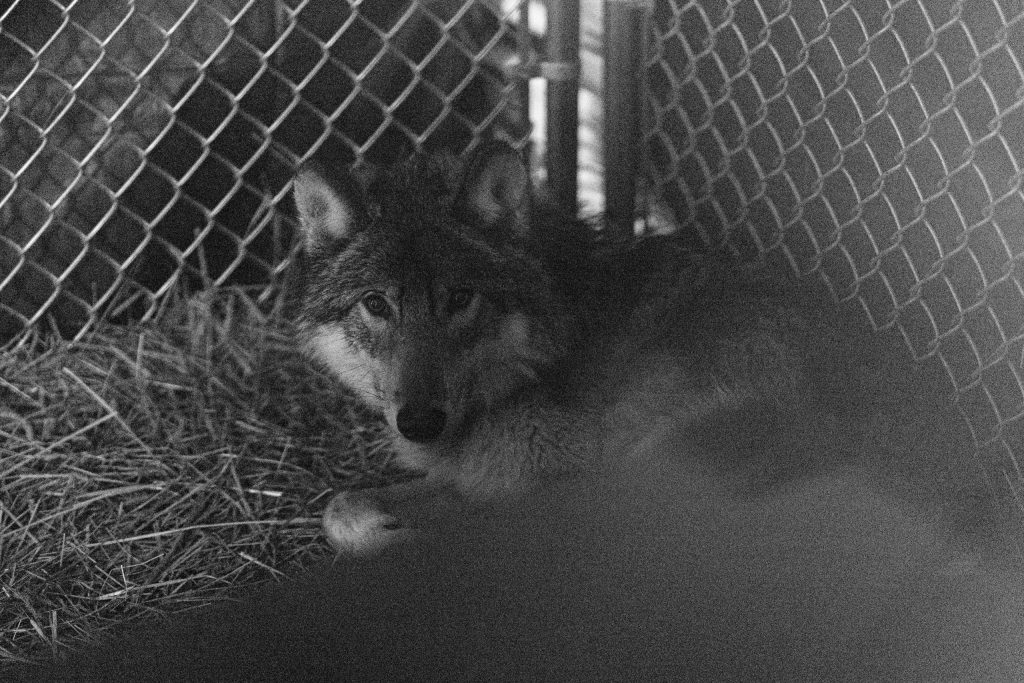
With the situation, various resources have been deployed in an attempt to reduce conflict with the pack. Brian Dreher, assistant director of Parks and Wildlife’s terrestrial wildlife branch, told the agency’s commission on July 17 that there has been an “incredibly intensive” human effort in the area.
“Staff have used various tools to detect where wolves are and work to create distance between livestock and wolves to the best of their ability,” Dreher said, listing the agency’s damage specialists, staff and range riders as well as Colorado Department of Agriculture staff and ranch staff among those involved.
These individuals are providing human presence and targeted hazing to attempt to deter the wolves from approaching livestock, Perkins said.
“Ranch staff have been very active the past several months in doing carcass management, livestock checks, and communicating with (Parks and Wildlife),” Dreher said.
Perkins added that “the producers in this area have been working constructively with (Parks and Wildlife’s) wildlife damage specialists on the deployment of all available and appropriate non-lethal conflict mitigation efforts.”
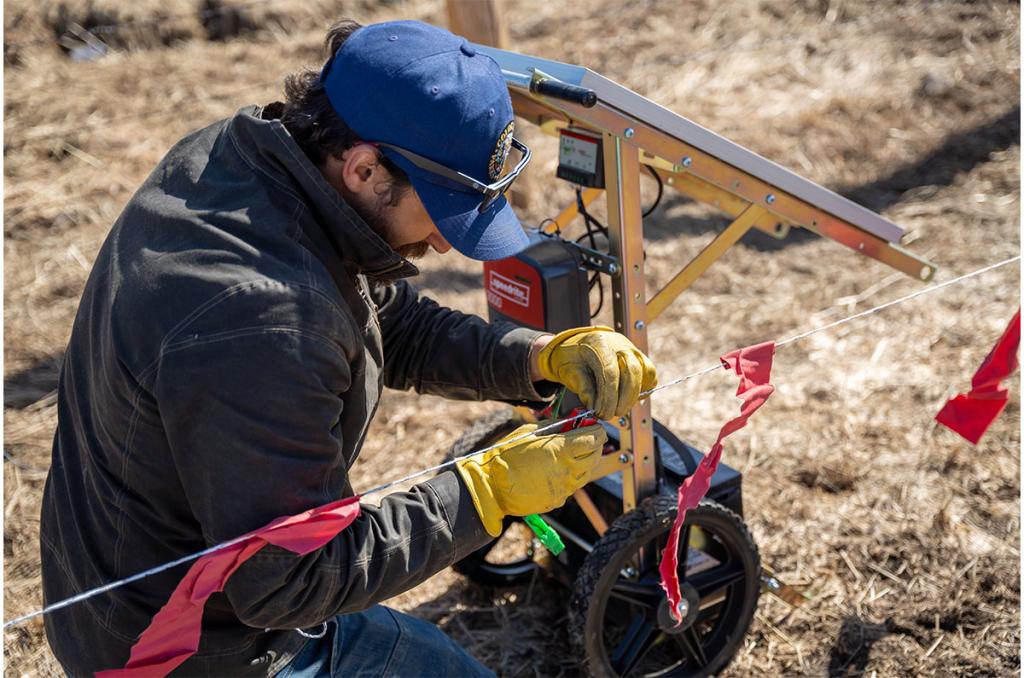
Parks and Wildlife staff have seen evidence the animals are also feeding on elk in the area.
“Local CPW staff have also observed elk carcasses that were fed on by wolves — including some believed to be kills, not merely scavenging — while working on game damage investigations, targeted hazing efforts and range riding,” Perkins said. “Staff have also repeatedly observed elk hair in wolf scat since releases occurred in January.”
The situation has caused “unbelievable stress” on the area’s producers and their families, Collins said.
“They’re working all day trying to put up their hay and irrigate their pastures and tend their cattle, and then they’re having to stay up late into the night to try and protect them,” he added.
The stress is not just impacting producers, Collins acknowledged.
“These officers who are working way more hours than they normally would with their normal job, they’re having to deal with spending four hours on a necropsy on a calf … videoing it and taking pictures and measuring how far the teeth marks are apart,” he said. “Those guys are doing a great job. They’re working really, really hard. And I feel for them like I do for the guys that work for us and the other cattlemen up here.”
Given the situation, Collins believes there is only one course of action.
“Our goal is not to eliminate the wolf program, but you have to take the bad actors that are doing the damage out of the picture,” Collins said. “I think the only way is to remove them from the scene, collect them up, and put them somewhere where they’re not getting around cattle or sheep.”
This sentiment has been echoed by other producers, stockgrowers and cattlemen’s groups, and elected officials who have pushed the agency to remove the entire pack. In July, the Colorado Cattlemen’s Association, the Middle Park Stockgrowers Association and the Holy Cross Cattlemen’s Association sent a letter to the commission, urging this course of action. The groups argued that the pack should have never been released back into the wild this year, per the agency’s wolf plan and agreements with Grand County producers last year.
“(Parks and Wildlife) also violated its agreement with the landowner and producer not to release those wolves onto the landscape after capture,” the groups wrote. “The landowner and producer would not have allowed CPW access because they did not want these depredating wolves to become someone else’s problem.”
Wildlife advocates, however, have continued to support Parks and Wildlife’s incremental approach and press for producers to utilize nonlethal tools to coexist with the wolves.
“It’s high time for wolves to be respected for who they are, rather than being used as unfeeling objects — as pawns — for people with different conservation or political agendas,” wrote Delia Malone and Marc Beckoff, both wildlife ecologists, in a blog post. “We brought wolves here and must do all we can to keep them alive.”
At the July 7 special meeting on the pack, Davis indicated that while the agency will continue to monitor, deploy tools, work with producers and complete whether additional lethal removals need to take place, full removal of the pack is unlikely at this point.
“We should not be indeterminately removing more wolves than we need to in order to address the human-wolf conflicts,” Davis said, adding that the agency will make the “minimum removals necessary to change the pack behavior and reduce future possible depredations.”

Support Local Journalism

Support Local Journalism
Readers around Steamboat and Routt County make the Steamboat Pilot & Today’s work possible. Your financial contribution supports our efforts to deliver quality, locally relevant journalism.
Now more than ever, your support is critical to help us keep our community informed about the evolving coronavirus pandemic and the impact it is having locally. Every contribution, however large or small, will make a difference.
Each donation will be used exclusively for the development and creation of increased news coverage.

